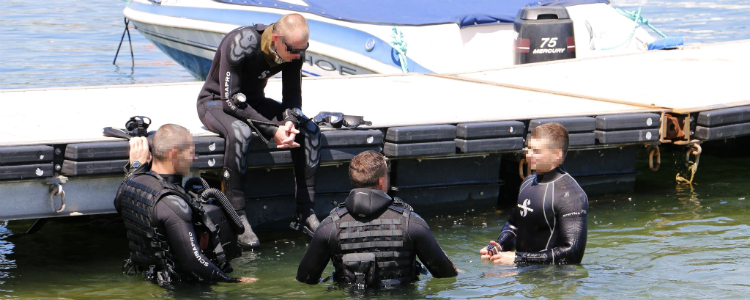In Odesa, training of special forces divers within the School of Military Divers project have just taken place, and we are glad to share some good news about it with you! Over this time, instructors taught basics of counter-saboteur work to the National Guard and UAF’s joint unit: the divers learnt how to swim in extreme conditions, dive holding one’s breath and handle newest Draeger equipment allowing to eliminate expelling bubbles that unmask a diver with an ordinary scuba gear.

Photo: Vsevolod Ananyev, Hromadske radio
To teach the military divers how to counter enemy attacks, the School of Military Divers instructors developed an intensive course encompassing two disciplines: learning the basics of water confidence training and master safe operation of the self-contained breathing Draeger apparatuses as well as the newest autonomous underwater vehicles. Let us dwell a bit on this.

Photo: National Guard’s Southern operative center
Water confidence training is the initial course aimed at adaptation to aquatic environment. It is an obligatory discipline which is taught at any professional diving schools, military diving institutions; a compulsory course for Navy divers and rescue teams with no exception.

Photo: National Guard’s Southern operative center
This course includes diving and snorkeling both in a pool and in the open sea; handling basic equipment (a mask, snorkel and fins); extending underwater breath-hold time as well as exercises imitating real situations like current, big waves sweeping over a diver; diving following a hard workload, for example, for rescuing a drowning person and other drills aimed to improve endurance and ability to work in the sea in extreme circumstances.

Photo: National Guard’s Southern operative center

A commander of a group of divers, a strong athletic man, admits that during the training he realized he nearly fainted. Luckily, our instructors paid attention to situations like this and taught divers how to avoid them. The 5 channel’s story tells about the impressions our military got during the course.
The chief coach and founder of the School of Military Divers, Kostyantyn Myrhorodskyi explains the specificity of this hard training: “The nature of load a diver experiences while underwater, differs from that on a surface a lot. Water does not like brute force and never forgives rash decisions. One can be a master of sports in weightlifting, still his entire background may prove totally useless when he swims in open waters in somewhat “fresh” weather conditions. You have to enhance your stamina by constant exercising and got used to water, – to be aware, for example, that you cannot breathe whenever you want, in high waves”.

Photo: National Guard’s Southern operative center
The course on handling a self-contained breathing Draeger apparatus included studying the structure of the gear and its constructive features, safety measures for diving sessions as well as essentials of its practical application.

Photo: National Guard’s Southern operative center
Actually, Draeger apparatuses make the underwater saboteurs’ main gear. Self-contained breathing Draeger apparatuses are designed for use by scout and saboteur divisions of military divers as well as for underwater de-mining. The air a diver breathes out, passes back into the gear, not in water. Thus there are no air bubbles emerging on the water surface, and the sound of breathing cannot be heard. Watch the following video by ZIK to learn how it works in practice.
Why did the instructors teach the National Guard special ops divers to use these peculiar apparatuses, you may ask? It’s simple: the gear has already been at the division’s disposal but was never used before. It is worth mentioning that a diver can work under the water undetected for about four hours!

Photo: Vsevolod Ananyev, Hromadske radio
Kostyantyn Myrhorodskyi emphasizes the importance of the fact that the volunteers “launched” these self-contained breathing apparatuses: “In real combat missions, you can use the gear of the kind solely. The apparatuses are rather sophisticated inventory, therefore their usage requires lots of skills and knowledge as compared to ordinary scuba gear – here you need to control oxygen and absorber as well as strictly observe the depth of submersion. Hopefully, regular training with this gear will become a consistent practice for the guys who have just taken our course”.

Photo: National Guard’s Southern operative center
Still, self-contained breathing Draeger apparatuses are not the only gear the military divers are to master. Follow the updates on the project – shortly we are going to show you how the underwater special ops fighters were taught to move under the sea superfast! Meanwhile, dear friends, we ask you to support the School of Military Divers: the instructors are continuing teaching the divers from various divisions and helping them to upgrade their equipment.























































